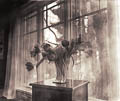Google Analytics
These fiber-based silver gelatin photographs and many others are available for purchase in very small editions.
Please click on thumbnails for more information.
click here for pricing.
click here for gallery locations and contact info.
click here for the Gallery Table of Contents
back
home
a world of ultra-long exposure
Russel Kwan
Click here for Fire in the Sky: Apollo's Commute Gallery
Click here for the Time's Arrow Gallery
Click here for technical information on ultra-long exposure photography.
“That’s impossible!” is the usual reaction I get when I try to explain the process behind these pictures. Impossible just takes a little longer than usual to figure out.
This body of work started with the simple idea of trying to photograph the sun crossing the sky. I have to admit that the idea itself isn't very unique - others have captured views of the sun using varying techniques. However, I believe I am the first to capture the arc of the sun on conventional film with conventional equipment, without filters, or even having to stop the lens down. A chemical process I’ve developed over the past couple of years enables these photographs, and control variables within the chemical process permit a range of image qualities from surreal to ultra-sharp-west-coast precision.
I am still working on this process, and finding things to do with it; at times this whole adventure feels like a classic “solution looking for a problem” sort of escapade. But – there really is something to a timeless form that we grow so used to that we are almost completely unaware of its existence – the path of the sun crossing the sky.
These two photographs (below) are the first successful images I made (after many months of incomplete and total failures). I am still very happy with them, despite several months of further development and improvement of the technique and technology that enabled them.
I shortly realized that another experiment of mine, the Dranoflex pinhole camera, could be left outside all day to record sun arcs. As I refined the process, I also discovered a means to make the amount of exposure film can take almost arbitrary. This group of photographs were made with the Dranoflex left outside for as long as two weeks - no filters were necessary, even for these extreme exposures.
About the same time, I started using the same extreme exposure technique to explore still photography of other long-term processes. This is my study of a vase of tulips wilting over two weeks.
A little later, while Wendy was developing her collection "Hard of Housing", I spent time at the same Little Mountain Public Housing site doing shorter term experiments with sunarcs - these exposures are in the 10 minutes to 60 minutes range, made variously with pinhole and large-format cameras.
As the process matured, I started photographing locations around our neighborhood and even further afield. Since I can only make one of these pictures per camera per day, progress is slow - but this exploration continues.
The west coast has become an important subject for this body of work. The open skies, the constant flow of weather, and the interesting locales make for a rich photographic experience. Wendy and I get out to the Washington and Oregon coasts at least once a year, so there is ample opportunity to continue exploring the path of the sun crossing the sky.

























